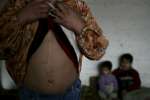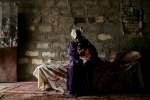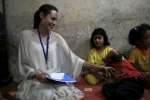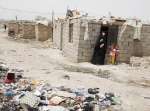- Text size
 |
|  |
|  |
| 
- Français
Iraqi artists in Syria get a rare chance to exhibit their work
News Stories, 25 March 2009

DAMASCUS, Syria, March 25 (UNHCR) – The UN refugee agency's Damascus office has opened an exhibition of widely diverse works by 22 Iraqis, giving them a rare chance to display their art to a wide and discerning audience.
More than 250 people attended the opening of "Transitions" on Tuesday night at the Iraqi Cultural Centre, including diplomats, Syrian government officials, refugees and aid workers. Several paintings were sold, bringing much needed income to some of the artists, most of whom are refugees.
UNHCR Acting Representative in Syria Philippe Leclerc, opening the display, said the art "reflects the talent and resourcefulness of the Iraqi population" as well as the "important insights that artists have on the situation of refugees and Iraq."
Most of the featured artists live in Damascus, unable to return home to Iraq for safety reasons. Others have paid brief visits to Iraq in recent months, but have not made a final decision to return. One artist never left Iraq, but has not been able to exhibit his art for several years because of the situation in Baghdad.

Calling themselves the "Babylon Artists," the group of painters – including four women – reflect the stories and livelihoods of Iraqi refugees in Syria and the wider region. Some works are rooted in traditional Arabic calligraphy. Others are purely abstract: from the heavy brushstrokes of red, yellow and green that meet in the centre of Wadhah Mahdi's paintings, to the clouds of colour that characterize Majid Hashim's work.
"I took my ideas from my country's art history," art teacher Hashim said, while adding: "There is a long history of the visual arts from ancient Iraqi culture, from the legacy of Babylon." A native of the ancient city, he fled to Syria with his wife and two children in 2006 after they were threatened by militias.
Omar Odeh's large abstract work, "Love Story," reflects his optimism about the situation in Iraq. He and his family fled to Damascus three years ago to escape a wave of sectarianism that was sweeping Iraq. He recently returned to Baghdad to visit family and friends and described the security situation as "much improved."
Unlike his artistic colleagues, Waleed Hassan was persecuted for his work by a group that objected to his representation of the human form in his art. In exile for seven months with his wife and two of his four children, Hassan uses colours and landscapes to remind him of a more peaceful Iraq.
He points to one painting of yellow-brown, red and blue and explains that it "is a memory of the marshes of southern Iraq, where people live above the water on small boats and simple houses." Another of his works depicts the countryside south of Baghdad where he and his family sought shelter at the start of the Gulf War of 2003.
A third painting shows the historic central quarter of Baghdad. Two figures make their way through the market, but their form is elongated, making them look as though they are swaying in the wind. "Baghdad's Old City does not exist as it once did," Hassan said. "But with many of these paintings, we try to capture the memories."

The Damascus exhibition, which will run until April 16, is part of an initiative launched two years ago by UNHCR and the European Commission's Humanitarian Aid Office (ECHO) to give refugees in Syria the opportunity to tell their stories.
The "Express Yourself" programme has supported several art exhibitions; established a website for Iraqi artists. A CD of Iraqi music is in the works and several films by Iraqi directors have been shown at film festivals in Syria, the United Kingdom and the United States.
By Frederick Deknatel in Damascus, Syria





























